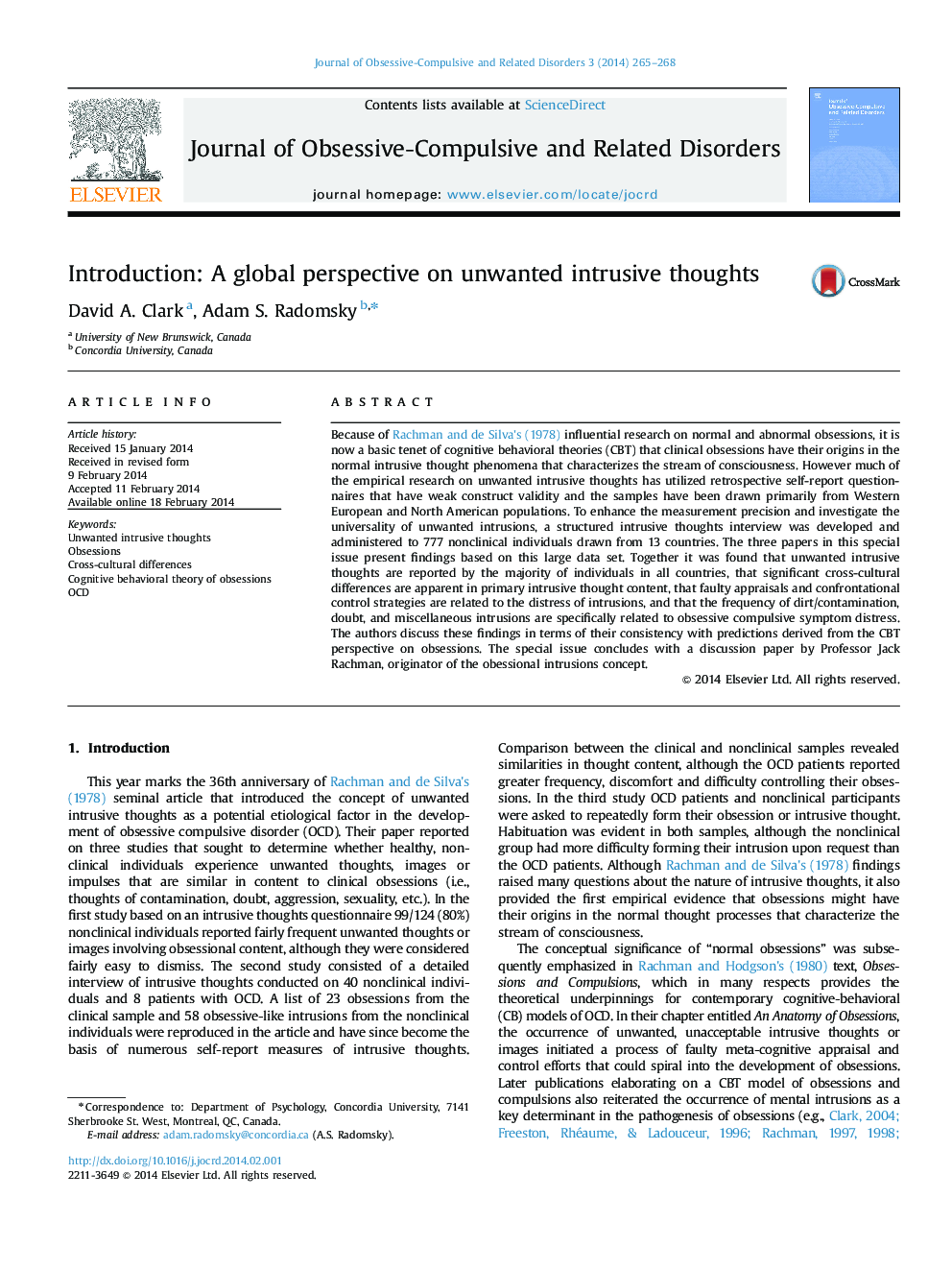| کد مقاله | کد نشریه | سال انتشار | مقاله انگلیسی | نسخه تمام متن |
|---|---|---|---|---|
| 912272 | 918203 | 2014 | 4 صفحه PDF | دانلود رایگان |
عنوان انگلیسی مقاله ISI
Introduction: A global perspective on unwanted intrusive thoughts
ترجمه فارسی عنوان
مقدمه: دیدگاهی جهانی به افکار مزاحم و ناخواسته
همین الان دانلود کنید
دانلود مقاله ISI انگلیسی
رایگان برای ایرانیان
کلمات کلیدی
افکار مزاحم ناخواسته -
وسواس -
تفاوت میان فرهنگی -
نظریه های رفتاری شناختی وسواس
فهرست مطالب مقاله
چکیده
کلید واژه ها
1.مقدمه
2.اهداف پژوهش حاضر
3. تاریخچه و گسترش
4.مسائل خاص
کلید واژه ها
1.مقدمه
2.اهداف پژوهش حاضر
3. تاریخچه و گسترش
4.مسائل خاص
ترجمه چکیده
به لطف تحقیقات تاثیرگذارِ (Rachman and de Silva's (1978 در زمینه وسواس های طبیعی و غیرطبیعی،در حال حاضر این امر که افکار بیمارگونه ریشه در افکار مزاحم و ناخواسته نرمالی دارد که مشخص کننده جریانِ خودآگاه هستند،یک اصل اساسی نظریه شناختی رفتاری (CBT) بشمار می رود. بااینحال اکثر تحقیقات تجربی در مورد افکار ناخواسته و مزاحم بر مبنای پرسشنامههای بازنگرانهای بوده که اعتبار ساختاری پایینی دارند و نمونههای مورد مطالعه عمدتا از جمعیت اروپای غربی و آمریکای شمالی انتخاب شدهاند.به منظور افزایش دقت اندازهگیری و بررسی جهان شمول این حریم گذریهای ناخواسته، 777 نفر افراد غیربالینی از 13 کشور در مورد افکار مزاحم مورد مصاحبهای یکسان و یکپارچه قرار گرفتند. یافته های بدست آمده از این مجموعه بزرگ داده، در سه مقاله ارائه شدند. از مجموع این داده ها مشخص شد که: افکار مزاحم و ناخواسته توسط اکثر افراد از تمامی کشورها گزارش شدهاست، تفاوت بین فرهنگی قابل توجهی بین محتوای اولیه افکار مزاحم وجود دارد، ارزیابی اشتباه و شیوههای کنترل و مواجهه با افکار پریشان و مزاحم در ارتباط است، و اینکه فراوانیِ آلودگی/خاک، شک، و حریمگذریهای گوناگون بویژه با علائم اضطرابِ اجباری وسواسی در ارتباط هستند. نویسندگان این یافتهها را از لحاظ همسانی با پیش بینیهای دیدگاهِ CBT در مورد وسواس، مورد بررسی قرار دادند. پرفسور جک راچمن،مبتکر مفهوم مزاحمتهای وسواسی، جمعبندی و نتیجهگیری ها در مورد این موضوع را در مقاله ای ارائه کردهاست.
موضوعات مرتبط
علوم پزشکی و سلامت
پزشکی و دندانپزشکی
روانپزشکی و بهداشت روانی
چکیده انگلیسی
Because of Rachman and de Silva׳s (1978) influential research on normal and abnormal obsessions, it is now a basic tenet of cognitive behavioral theories (CBT) that clinical obsessions have their origins in the normal intrusive thought phenomena that characterizes the stream of consciousness. However much of the empirical research on unwanted intrusive thoughts has utilized retrospective self-report questionnaires that have weak construct validity and the samples have been drawn primarily from Western European and North American populations. To enhance the measurement precision and investigate the universality of unwanted intrusions, a structured intrusive thoughts interview was developed and administered to 777 nonclinical individuals drawn from 13 countries. The three papers in this special issue present findings based on this large data set. Together it was found that unwanted intrusive thoughts are reported by the majority of individuals in all countries, that significant cross-cultural differences are apparent in primary intrusive thought content, that faulty appraisals and confrontational control strategies are related to the distress of intrusions, and that the frequency of dirt/contamination, doubt, and miscellaneous intrusions are specifically related to obsessive compulsive symptom distress. The authors discuss these findings in terms of their consistency with predictions derived from the CBT perspective on obsessions. The special issue concludes with a discussion paper by Professor Jack Rachman, originator of the obessional intrusions concept.
ناشر
Database: Elsevier - ScienceDirect (ساینس دایرکت)
Journal: Journal of Obsessive-Compulsive and Related Disorders - Volume 3, Issue 3, July 2014, Pages 265–268
Journal: Journal of Obsessive-Compulsive and Related Disorders - Volume 3, Issue 3, July 2014, Pages 265–268
نویسندگان
David A. Clark, Adam S. Radomsky,
